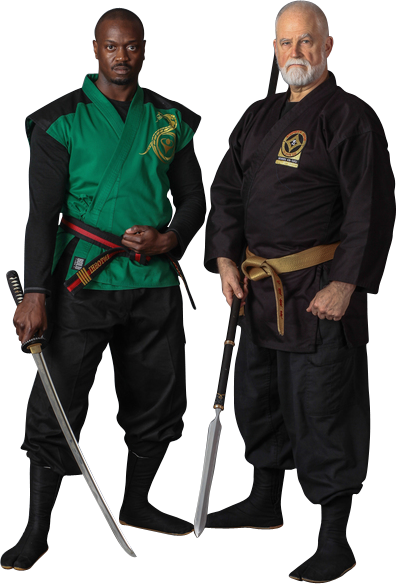
“Ninja! You are the guys that throw a lot of high kicks.”
“I’ve heard of ninja; that is an assassin’s art.”
“Oh yeah, Ninja! Those nunchuck experts like Bruce Lee.”
“Ninja are the guys that run around in black pajamas.”
These are all actual statements I have heard in my time as a modern Ninjutsu
practitioner. During my beginning years in the art I use to get very frustrated by
these comments. However over the years I have grown to view these comments in
another way. In self-reflection I remember that there was a time I had no idea what
a ninja was. All I knew was what I saw on television. This is most people’s experience.
Only after diligent research and a little luck did I find my way to Stephen K. Hayes
(the first American to study the Ninja art), who became my teacher and friend. As
my time with him grew, I realized that my understanding of how to explain Ninjutsu
was not any easier. If a person asked me about it, but didn’t have a half hour to listen
to the response, then I could not give them a good answer. Even today, explaining
the art to someone who walks into my school is no easy task. My answer is usually
based on their first question. Or, if their first question is “What do you do here?,” I tell
them “We study the art of success and perseverance. Our art’s foundation is learning and gaining what we need to succeed in life Mentally, Physically and emotionally.”
Sometimes you can see that, for the parents just wanting to get their child in
Karate, this may be way too much, so I tone it down a bit for my audience. Thus, my
description is ever-changing.
Pondering this gave me an epiphany during my training. I tell my students all the time “You don’t have to fit Ninjutsu; it will fit you.”
I explain to them that, with an art that simply translates to the art of endurance/
perseverance, we are being trained in the understanding of flexibility and
adaptability above all else. It is, in essence, our duty to become or gain what we need
in order to be successful.
Because life brings many challenges, above all Ninjutsu teaches us an
analytical and philosophical approach to understanding endurance and success,
whether it is against a bully in the playground, a bully in the corporate office, a self-created personal challenge, or an environmental one. Giving up is never and option, but finding a way through always is. Essentially, Ninjutsu is about living.
Taking this concept of flexibility one-step further, To-Shin Do Ninjutsu is based
on an elemental teaching structure. Each belt color correlates to an element and each element teaches us a way of emotional, mental and physical action, reaction and understanding. Life is not about one way of doing things. It is a culmination
of people with different ideas and ways of doing things. We learn this through the
elemental structure.
Earth confident and strong; water is scientific and analytical;
fire is passionate and connected; wind is multi-functioning and ever present.
Each element also has a negative side. Earth is stubborn and arrogant; water is
disconnected and introverted; fire is aggressive and abrasive; wind is flighty and
aloof.
How would one explain all this in a fly-by meeting, where someone asks what is
Ninjutsu? It seems impossible, which leads me to my final point. In the past, Ninja
were successful because no one knew who they were or how to explain what they
were. This difficulty in identifying them was part of the stealthy nature of the Ninja.
Invisibility is not just about wearing dark pajamas – anyone can do that. Instead, one
aspect of being stealthy is being tough to identify. The irony is that all these years
later the stealth nature of Ninjutsu is not hindering the enemy any more, but instead
it has become a lesson and challenge for its modern practitioners trying to bring
its light to the modern day.
I find it beautiful and poetic – the idea that something designed more than 900 years ago is still a mystery to explain today. I know what it is in my heart and mind: as the master once said, “Ninjutsu is living.”
I ask you what does that mean exactly?



